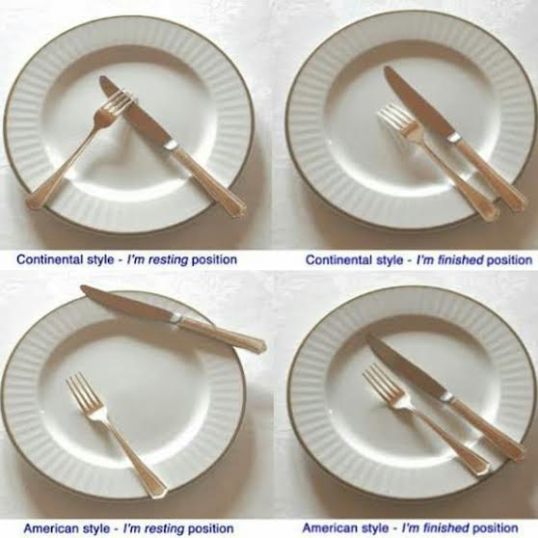The Fork of Identity
I haven’t written in this beloved blog for many months. Since the last post I have come to Europe–Barcelona, Spain specifically–and although it’s only been about six months, it feels like years! Adaptation and growth can indeed feel like a pressure cooker I suppose.
I could write about many things to open the Europe chapter of this blog, but one topic comes to mind specifically: table etiquette.
I remember how Alexia ate, a dear French friend I met in college. I remember thinking it was quite “pretty” the way she held the utensils and used both at the same time. I quite honestly had forgotten about it since coming to Europe, but of course it’s come to my full attention. How could it not? Recently someone commented on the way I changed hands when eating. To him, it was quite strange and far from elegant. The process is as follows: American Style: Knife in right hand, fork in left hand holding food. After a few bite-sized pieces of food are cut, place knife on edge of plate with blades facing in. Eat food by switching fork to right hand (unless you are left handed). A left hand, arm or elbow on the table is bad manners.
Placing the knife on the edge of the plate and switching hands was like turning on automatic pilot, and it’s moments like this when you realize just how American you are! The American style of eating seemed like a lot of extra and unnecessary work to him, but what was far worse of an offense was that my left hand was not visible, but according to the description above from “United States Dining Etiquette Guide,” having your left hand or arm visible on the table is bad manners in the US of A! There are many ways to spot an American tourist: college and professional sports paraphernalia, tennis shoes, fanny packs, and the infamous North Face jacket, among others. I never took part in the fanny pack craze (and never will for that matter), and I prefer Converse over Nike thanks to Argentina, but apparently, the hand I use to hold my fork is also a dead giveaway of my nationality! Let’s call it the “fork of identity.”
It’s more accurate to call it the “North American style” instead of the “American style” as this also is the common way to eat in Canada. In comparison, here is a description of the Continental/European Style: Knife in right hand, fork in left hand. Eat food with fork still in left hand. The difference is that you don’t switch hands-you eat with your fork in your left hand, with the prongs curving downward. Both utensils are kept in your hands with the tines pointed down throughout the entire eating process. If you take a drink, you do not just put your knife down, you put both utensils down into the resting position: cross the fork over the knife.

In the early nineteenth century in Europe, shifting forks back and forth while eating was not only accepted but also common believe it or not. It was around 1850 when the upper class changed this and the Continental/European style became fashionable. A French etiquette book of the time stated: “If you wish to eat in the latest mode favored by fashionable people, you will not change your fork to your right hand after you have cut your meat, but raise it to your mouth in your left hand.” Although the “Continental” approach is also accepted in North America, it is far less common, and the opposite is not true. The North American style stays on that side of the world and most Europeans today have their preferred style.
It’s debatable among etiquette historians where the “switch and then switch again” North American style came from. Some etiquette books teach that it came to the States along with the British colonists, where others infer that Americans created it to be different, to keep in line with their pioneering ways. Last week I happened to be at a dinner full of expats and sat next to an American who had been living in Europe for more than 15 years, and across the table was another with less years to his European CV. I quietly watched to see how they ate, and neither of the two would have revealed their nationality based on how they held their fork. They both used the European style with ease. I asked Rob next to me when he changed his eating style, and he was struck by my question. He admitted he hadn’t thought about it in years, if ever at all, and he thinks he goes back and forth between the two styles depending on where he is.
I imagine this topic comes up for many Americans living abroad and/or in Europe often. Despite having an EU Passport and living across the Atlantic, my identity as an American can’t and won’t change…but I think my fork will!
